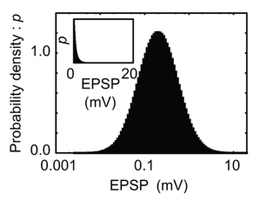疎な強結合と密な弱結合が共存する興奮性ネットワークでの最適なスパイク伝達コミュニケーション
Optimal spike-based communication in excitable networks with strong-sparse and weak-dense links
2012年7月2日 Scientific Reports 2 : 485 doi: 10.1038/srep00485

多くの物理、生物、社会システムにおいて複雑ネットワークの結合性と機能的意味はこれまで多くの関心を集めてきた。しかし、結合強度分布の重要性は、ガウス分布や一様分布などを除くと、ほとんど明らかにされていない。本論文では、神経ネットワークが裾野の長い結合強度分布によって頑健な内的ノイズを生成し、スパイク伝達を最適にしている事を、解析的かつ数値的に示す。密な弱結合が興奮性活動をノイズ源としてネットワーク全体に再分配し、疎な強結合に対する個々の神経細胞の応答性を最適に向上させる事が、この内的な自発活動の構造である。電気生理学的実験により、このモデルが支持する結合強度の広い分布の重要性も確認された。今回の結果は、安定性と最適な通信の両者に寄与する内的ノイズを生成する、結合の強い不均一性によるシンプルなメカニズムを明らかにしている。
寺前 順之介1,4, 坪 泰宏1 & 深井 朋樹1,2,3
- 理化学研究所 脳科学総合研究センター
- 理化学研究所・次世代計算科学
- CREST・科学技術振興機構
- さきがけ・科学技術振興機構
The connectivity of complex networks and functional implications has been attracting much interest in many physical, biological and social systems. However, the significance of the weight distributions of network links remains largely unknown except for uniformly- or Gaussian-weighted links. Here, we show analytically and numerically, that recurrent neural networks can robustly generate internal noise optimal for spike transmission between neurons with the help of a long-tailed distribution in the weights of recurrent connections. The structure of spontaneous activity in such networks involves weak-dense connections that redistribute excitatory activity over the network as noise sources to optimally enhance the responses of individual neurons to input at sparse-strong connections, thus opening multiple signal transmission pathways. Electrophysiological experiments confirm the importance of a highly broad connectivity spectrum supported by the model. Our results identify a simple network mechanism for internal noise generation by highly inhomogeneous connection strengths supporting both stability and optimal communication.

